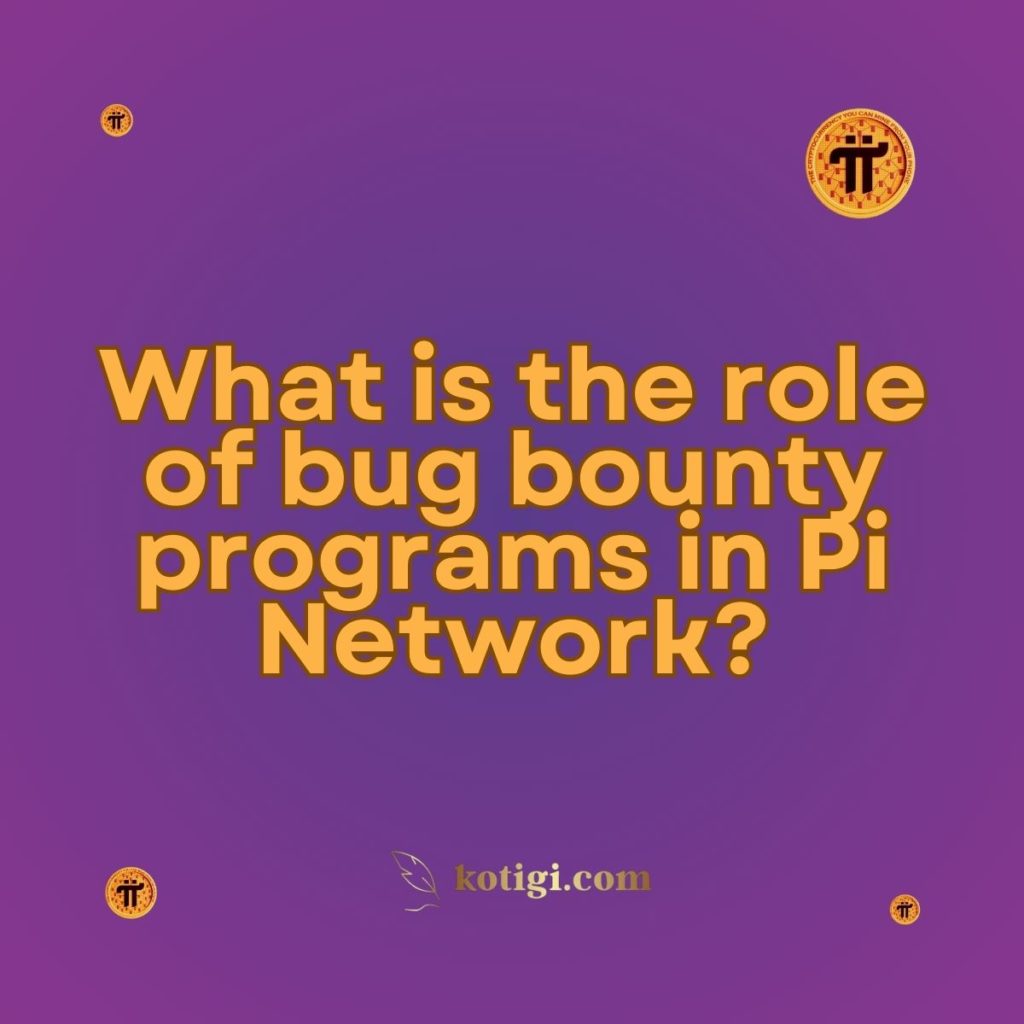
What is the role of bug bounty programs in Pi Network?
Bug bounty programs in Pi Network serve as a crucial mechanism for identifying and addressing vulnerabilities, fostering a secure environment for users, and enhancing the overall integrity of the network through community-driven efforts.
Introduction
In the fast-paced world of blockchain technology, security is paramount. As new projects emerge and existing networks expand, the risk of vulnerabilities and attacks increases. Pi Network, a pioneering project aimed at making cryptocurrency accessible to everyone, recognizes this challenge and has implemented a robust bug bounty program. This initiative encourages ethical hackers to discover and report vulnerabilities in exchange for rewards. In this article, we will explore the multifaceted role of bug bounty programs in Pi Network, examining their structure, benefits, and impact on the broader ecosystem.
1. Understanding Bug Bounty Programs
1.1 What is a Bug Bounty Program?
A bug bounty program is a structured initiative that invites independent security researchers and ethical hackers to find and report security vulnerabilities in a software application or system. In return, these individuals receive monetary rewards or other incentives for their findings.
1.2 Historical Context of Bug Bounty Programs
The origins of bug bounty programs can be traced back to the late 1990s when organizations began to realize the value of crowd-sourced security testing. Pioneers like Netscape established the first formal bug bounty program, setting a precedent that has led to widespread adoption across tech companies and organizations today. This approach not only helps identify vulnerabilities but also builds a collaborative relationship between users and developers.
1.3 Types of Vulnerabilities Targeted
Bug bounty programs focus on various types of vulnerabilities, including:
- Security Flaws: Issues that could be exploited to gain unauthorized access or compromise user data.
- Performance Bottlenecks: Problems that hinder the efficiency and scalability of the network.
- Code Errors: Bugs that can lead to crashes, unexpected behaviors, or security vulnerabilities.
2. The Importance of Bug Bounty Programs in Pi Network
2.1 Enhancing Security Measures
By proactively identifying vulnerabilities, bug bounty programs serve as a crucial layer of defense for Pi Network. They enable the project to address potential threats before they can be exploited, ensuring a safer environment for all users. This proactive approach is essential for maintaining user trust and network integrity.
2.2 Fostering Community Engagement
Bug bounty programs encourage community involvement by empowering users to contribute to the network’s security. This collective effort not only enhances security but also fosters a sense of ownership and responsibility among community members. When users feel invested in the platform’s security, they are more likely to engage positively with the ecosystem.
2.3 Building Trust and Credibility
By actively seeking vulnerabilities and addressing them transparently, Pi Network can build trust with its user base. Users are more likely to engage with a platform that demonstrates a commitment to security, leading to greater participation and investment in the network.
2.4 Cost-Effective Security Solution
Engaging ethical hackers through bug bounty programs can be a cost-effective strategy compared to hiring full-time security personnel. It allows organizations to leverage the skills and expertise of a diverse pool of talent without incurring significant overhead costs. This flexibility enables Pi Network to allocate resources more efficiently.
3. Structure of Pi Network’s Bug Bounty Program
3.1 Eligibility Criteria for Participants
Participants in Pi Network’s bug bounty program must meet specific eligibility criteria. This includes having a strong understanding of security practices, knowledge of the network’s architecture, and a proven track record of responsible vulnerability disclosure.
3.2 Reward System for Bug Reporting
The reward system typically includes varying compensation levels based on the severity and complexity of the reported vulnerabilities. For example, critical vulnerabilities may attract larger rewards, while lower-severity issues might receive smaller compensation. This tiered approach incentivizes participants to focus on the most impactful vulnerabilities.
3.3 Reporting Process
The reporting process for Pi Network’s bug bounty program is structured to ensure clarity and efficiency. It generally includes:
- Submission: Participants must provide detailed documentation of the vulnerability discovered, including steps to reproduce the issue.
- Review: The security team evaluates the report for validity, assessing the severity and potential impact.
- Resolution: Once validated, the team implements necessary fixes, ensuring the vulnerability is addressed effectively.
3.4 Communication Channels
Establishing clear communication channels is vital for the success of the bug bounty program. Pi Network provides various platforms, such as dedicated forums, email support, or chat channels, to facilitate prompt responses to queries and report submissions. This open communication fosters collaboration and encourages participants to engage with the program.
4. Challenges of Implementing Bug Bounty Programs
4.1 Managing Community Expectations
One of the challenges faced by Pi Network is managing community expectations regarding the bug bounty program. Clear communication about the program’s goals, limitations, and timelines is essential to avoid misunderstandings and frustration among participants.
4.2 Ensuring Quality of Reports
Not all submissions to the bug bounty program will meet the required standards. Establishing guidelines for report quality helps streamline the evaluation process and ensures that valid issues are prioritized. This can include providing templates or checklists for participants to follow when submitting reports.
4.3 Addressing Vulnerability Disclosure
The handling of vulnerability disclosures is a sensitive matter. Pi Network must develop policies to manage the timing and method of vulnerability disclosures to minimize risks to users. This includes deciding when to publicly disclose vulnerabilities and how to communicate fixes to the community.
4.4 Potential for Abuse
While the program is designed to encourage ethical behavior, there is always a risk of participants exploiting vulnerabilities for personal gain. Implementing strict guidelines and monitoring systems is necessary to mitigate this risk and ensure the integrity of the program.
5. Success Stories from Bug Bounty Programs
5.1 Case Studies of Successful Vulnerability Fixes
Several organizations have effectively resolved critical vulnerabilities through bug bounty programs. Highlighting these success stories can demonstrate the efficacy of such initiatives. For instance, in 2021, a well-known blockchain platform successfully identified and patched a critical vulnerability that could have led to significant financial losses.
5.2 Positive Impact on Community Trust
Successful resolution of vulnerabilities not only enhances security but also strengthens community trust. When users see that vulnerabilities are addressed swiftly and effectively, they feel more secure and engaged with the platform.
5.3 Recognition of Contributors
Recognizing the contributions of ethical hackers is essential for fostering goodwill within the community. Acknowledging their efforts through public commendations, social media shout-outs, or monetary rewards can motivate further participation and create a culture of collaboration.
6. Future of Bug Bounty Programs in Pi Network
6.1 Expansion of Program Scope
As Pi Network continues to evolve, there may be opportunities to expand the scope of the bug bounty program. This could include exploring new areas of security or incorporating more complex systems that emerge as the network grows.
6.2 Integration with Other Security Measures
Bug bounty programs should not exist in isolation. Integrating them with other security measures, such as regular security audits, penetration testing, and automated vulnerability scanning, can create a more comprehensive security strategy that enhances the overall safety of the network.
6.3 Continuous Community Involvement
Encouraging ongoing community involvement in security initiatives is vital for the program’s long-term success. This could involve providing educational resources, hosting webinars, or organizing workshops for participants to share knowledge and best practices.
6.4 Leveraging Advanced Technology
As technology continues to advance, Pi Network can leverage tools and methodologies for vulnerability detection. Incorporating artificial intelligence and machine learning into the bug bounty program could enhance its effectiveness by automating certain processes and identifying patterns in vulnerability reports.
7. How to Participate in Pi Network’s Bug Bounty Program
7.1 Getting Started
To participate in Pi Network’s bug bounty program, users should familiarize themselves with the program’s guidelines and objectives. Understanding the network’s architecture, common vulnerabilities, and security best practices is crucial for effective participation.
7.2 Necessary Skills and Knowledge
Participants should possess skills in areas such as:
- Ethical Hacking: Knowledge of penetration testing techniques and methodologies.
- Programming: Proficiency in coding languages used within the Pi Network ecosystem.
- Cybersecurity: Familiarity with security protocols, vulnerabilities, and best practices in the blockchain space.
7.3 Resources for Learning
Pi Network can provide resources to help participants enhance their skills. This could include access to tutorials, documentation, links to relevant online courses, and forums for discussing security issues. Investing in community education can yield long-term benefits for the network’s security.
8. The Role of Ethical Hackers in the Blockchain Ecosystem
8.1 Contribution to Network Security
Ethical hackers play a crucial role in securing blockchain networks by identifying vulnerabilities that traditional security measures may overlook. Their unique perspectives and skills contribute significantly to the overall security posture of the network.
8.2 Bridging the Gap Between Users and Developers
Ethical hackers serve as a bridge between the user community and developers, providing valuable feedback and insights that can enhance the overall user experience. Their contributions can lead to better design choices and more secure applications.
8.3 Promoting Responsible Disclosure Practices
Ethical hackers promote responsible disclosure practices by ensuring that vulnerabilities are reported and addressed promptly. This minimizes risks to users and helps maintain the integrity of the network.
9. Community Feedback and Improvement
9.1 Gathering User Feedback
Regularly soliciting feedback from the community can help improve the bug bounty program. Users can provide insights into their experiences, suggestions for enhancements, and identify areas where the program could be more effective.
9.2 Iterative Program Development
The bug bounty program should evolve based on community feedback and the changing landscape of cybersecurity. Regular updates and adjustments will ensure that the program remains effective and relevant to the needs of the network.
9.3 Transparent Communication
Maintaining transparent communication regarding program updates, vulnerabilities discovered, and resolutions builds trust within the community. Sharing success stories and acknowledging contributions fosters a positive environment for collaboration.
Conclusion
Bug bounty programs are a vital component of Pi Network’s security strategy. By encouraging ethical hackers to identify vulnerabilities and providing a structured framework for reporting, Pi Network can create a secure environment for its users. The ongoing collaboration between the community and developers will be essential in fostering a resilient ecosystem as the network continues to grow and evolve.
Key Takeaways
| Key Takeaway | Details |
|---|---|
| Importance of Bug Bounty Programs | These programs enhance security by identifying vulnerabilities before exploitation occurs. |
| Community Engagement | Encouraging community involvement fosters a sense of ownership and responsibility. |
| Structured Reporting Process | A clear reporting process ensures valid vulnerabilities are prioritized and addressed. |
| Challenges to Overcome | Managing expectations and ensuring quality reports are crucial for program success. |
| Future Opportunities | Expanding the program’s scope and integrating advanced technologies can enhance effectiveness. |





